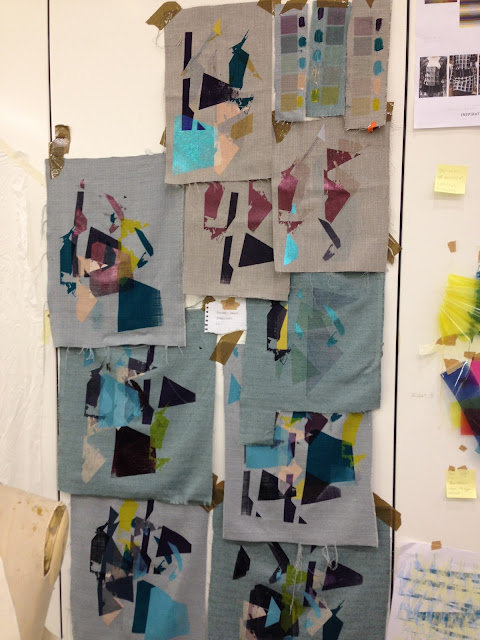Preparing for the next crit, I realised my work was not focussed - there were a lot of ideas but they weren't developed. Moving forward, I will edit and select pieces that I would like to develop and leave the ones that aren't working behind.
Materials were also a problem, and since the crit I have purchased synthetic upholstery materials so I can combine sublimation printing with screen printing and digital embroidery. I feel they are more sophisticated and appropriate for my context.
The colours I used looked washed out on the fabrics I was using previously, so I have adapted my original colour palette, which I think will compliment the fabrics, to take forward. I do not plan to use the 'fig' colour palette as a result of this as I feel the one below is more suitable for current interior trends.
 |
| Developed Colour Palette |
 |
| Sublimation of colours onto sourced upholstery fabrics |
I prepared a background on the fabrics before working on them with print and embroidery using sublimation printing, flocking and foiling - which is commonly used within interior fabrics and I feel is more playful than what I have created previously. I like having a textured surface to print onto because of the different effects it creates on the fabric when layered up.
Examples of recent work above - combining flock, foil, embroidery and screen print.
Compared to previous pin-ups of my work, I think my project is really starting to take shape. The fabric choices are far more sophisticated and relevant to my context. The combination of processes, I feel is better thought out and they complement each other. The colours also are much more appropriate than the duller ones I used previously. I could definitely see these fabrics used within an interior environment. I like the simple designs that incorporate just flock and foil, however, the brighter screen-printed ones also are cohesive and relevant to my context.
To move forward, I will further edit and select elements of the samples that work best and adapt these into new designs. I would screen print initially onto the fabrics rather than sublimation printing, as the colours would be richer. It was definitely easier to use a screen rather than newsprint paper, so I will always carry out the process of printing this way from now on.




























